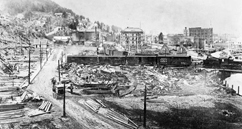FASCINATING HINCKLEY HISTORY
THE GREAT HINCKLEY FIRE
In the morning of September 1, 1894, a smart breeze sprang up from the south fanning the fires which extended over the thousands of acres southeast and west of Hinckley. In all, 459 people perished in Hinckley and surrounding villages, with virtually all the structures wiped out.
The fierce flaming heat became so intense in certain localities, it created what seemed to be a vacuum. The vacuum would then quickly fill with violent and explosive gases; yet at times appear entirely at rest in spite of the brisk south wind.
It was no ordinary fire. It came too quickly for analysis. It baffled science. It could not be accounted for. It was a phenomenon that defies all description. It did not crawl or creep but burst and exploded. It roared, seethed and boiled. On the ground it swept forward in walls and cylinders of flame; in the air it soared in massive balls of fire and gas.
It is doubtful if any other fire that may have wrought such destruction in this country ever possessed the power of that which destroyed Hinckley.
THE LIFE AND TIMES OF TOM “BOSTON” CORBETT
Standing outside the blazing Garrett barn, Tom “Boston” Corbett fired the fatal shot that killed John Wilkes Booth, President Lincoln’s assassin. Corbett achieved considerable fame after the shooting in 1865.
Several years later, he moved to Kansas where he was hired as assistant doorkeeper at the Kansas State Capitol. This job appealed to him and he proudly appeared for duty with his army cap and .38 “hot leg” strapped to his Civil War belt. He relished attention, and attention he soon found.
On February 15, 1887, things got out of hand when a legislator mocked Corbett. His fiery temper lead him to draw his gun and shout, “Legislature is adjourned!” Corbett was promptly arrested, tried and pronounced insane. He was sent to an asylum in Topeka.
On May 26, 1888, he escaped on horseback with a number of inmates. He fled Kansas and disappeared into the remote forests of Hinckley. Here he settled in a small cabin just east of town, earning a living supplying venison for a logging camp near the Kettle River.
On September 1, 1894, the final chapter of Corbett’s eventful life was written. His name was included on the certified list of those who perished in the Great Hinckley Fire.
JIM JORDAN’S BIG BUCK
Jim Jordan was a woodsman nearly all of his life. He was a logger, trapper, farmer and he enjoyed hunting. He had many good-sized buck racks hanging on the walls of his house.
On the morning of November 20, 1914, Jim, at the age of 22, shot a huge buck that weighed nearly 400-pounds. The news of his mammoth whitetail spread quickly and many of his friends and neighbors had to get a glance at the monster for themselves. One spectator was George Van Castle, who loved to do taxidermy as a hobby. He offered to mount the head for five dollars for Jordan, and Jordan accepted.
Van Castle’s wife became ill and they moved to Hinckley, yet he never told Jordan of the move. Over time the buck’s mount that was promised never materialized. Jordan thought he would never see the buck again.
Fifty years later, a shirttail relative of Jordan’s named Robert Ludwig found an old
dusty deer mount at a rummage sale in Sandstone, Minnesota. Ludwig, a forester for Minnesota’s Department of Natural Resources paid $3 for the rack and had the antlers measured by the Boone and Crockett awards program board. The measurement score of an unbelievable 206 5/8, set this buck at a new world’s record. Upon visiting Ludwig, Jordan knew this buck was the one he shot fifty years ago. Ludwig disagreed, and sold the deer for $1500 to an antler collector who still owns the rack.
Eventually, in 1978, the record was set straight in the Boone and Crockett record books and Jordan was accredited with killing the trophy buck. Ironically, Jordan passed away that year, at the age of 86, and never learned that his name would appear in the record books.





